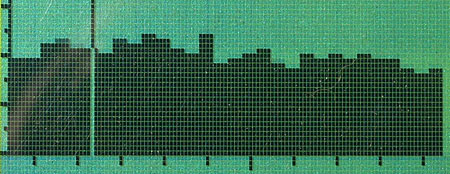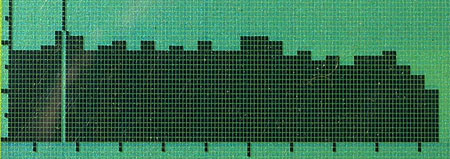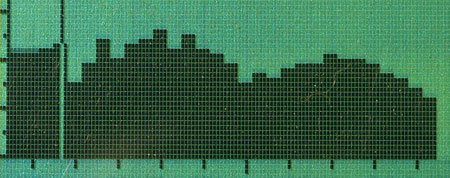Denon AVR-5805 AV Surround Receiver Measurements
MultEQ
The results of the final MultEQ equalization on my system and room (see the text) are in Figs. 3-6. For clarity the plots shown are 1/3 octave, though the MultEQ system provides far greater resolution. Only the results for the left speaker (plus subwoofer) are shown. Also note that the subwoofer level was set to produce the flattest response in the unequalized plots shown, and then set to the same position for the equalized shot.
All measurements were made with the Sencore SP295 SoundPro Audio Analyzer, and microphone, in full range operation (25Hz-20kHz). The cursor is at 80Hz in Fig.3 and 50Hz in Figs. 4-6.

Fig.3 Center seat, equalization "Off"

Fig.4 Center seat, equalization set to "Flat"

Fig.5 Left seat, equalization "Off"

Fig.6 Left seat, equalization set to "Flat"
Standard Bench Tests
All measurements were taken on the left channel. The Denon AVR-5805's frequency response from the analog CD input to the speaker out (Stereo mode, which leaves digital processing in the circuit) was –0.78dB at 10Hz, -0.26dB at 20Hz, -0.16dB at 20kHz, and -23.93dB at 50kHz.
In Pure Direct mode, the corresponding measurements from the analog CD input to the speaker out were –0.38dB at 10Hz, -0.10dB at 20Hz, -0.06dB at 20kHz, and -0.40dB at 50kHz.
The response from the multichannel input to the speaker output, in DSP (digital processing) mode measured –0.78dB at 10Hz, -0.26dB at 20Hz, -0.24dB at 20kHz, and -24dB at 50kHz.
The response from the multichannel input to the speaker output, in Analog (bypass) mode measured –0.40dB at 10Hz, -0.12dB at 20Hz, -0.06dB at 20kHz, and -0.39dB at 50kHz.
The Dolby Digital frequency response (optical input to speaker output) measured -0.08dB at 20Hz and -0.21dB at 20kHz in the left channel, and -0.07dB at 20Hz and -0.17dB at 20kHz in the center. With the left-surround channel set to "small" and the crossover frequency set to 80Hz, the high-pass filter response was –6dB at 61Hz, –3dB at 81Hz, and –0.22dB at 20kHz. The subwoofer line output, normalized to the response at 40Hz, was -1.27dB at 20Hz, -3dB at 120Hz, and –6dB at 125Hz.
The S/N (A-weighted, 2.83V into 8Ω) measured –109dB. Gain measured 28.6dB, CD in to speaker out, with an 8Ω load and the level control set to "0.0."
THD+noise in two-channel operation at 2.83V into either 8 or 4Ω measured 0.004% at 20Hz, 1kHz, and 20kHz.
With only two channels operating at 1kHz, the Denon clipped at 241Wpc into 8Ω and 394Wpc into 4Ω.
Driving seven channels into 8Ω, the Denon delivered 178Wpc at 20Hz and 184Wpc at 1kHz (to the nearest watt) before clipping (1% THD+noise). Into 4Ω (the last measurement taken), however, with seven channels operating, the amplifier's output stages failed, likely due to an internal blown fuse in a high voltage power supply. The front panel remained illuminated and functional, and the receiver continued to produce a signal at its low-level line outputs).
The Denon, like many receivers, is rated for operation from 6-16Ω, not into 4Ω But our standard procedure is to test receivers and amps into 4Ω, since the impedance of many popular speakers drops this low, or lower, at some frequencies. As noted in the review, the amplifier drove speakers with minimum impedances at or near 6Ω without difficulty at high levels on normal program material, in 5.1-channel operation. If you intend to set up two simultaneously functioning 5.1-channel systems from the Denon, however, I would recommend choosing loudspeakers that present a relatively benign load.—TJN
- Log in or register to post comments




































































